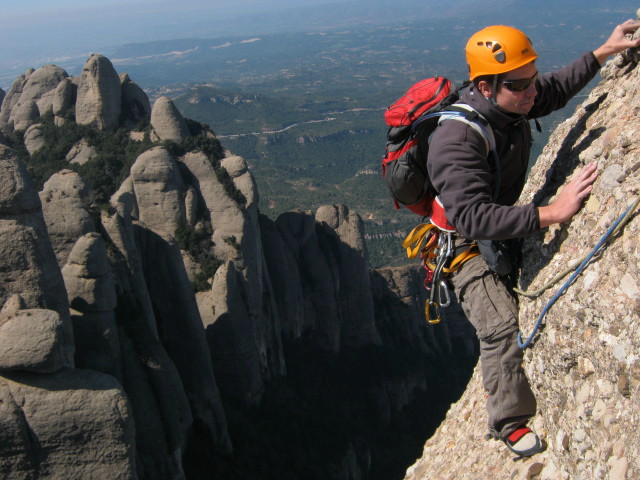




TOPO Climbing | CLIMBING7.COM
Publié le

This via classica, classified as via blava (blue), runs along the back of the aiguille du Bisbe (bishop's needle), on its south-west face. A very accessible IV/V climb, it offers an exceptional view of the Frares Encantats area and its strangely shaped needles clustered beneath our feet. A very aerial atmosphere, as the ascent is just a few steps from the 250m of the impressive north face of Le Bisbe. The fact remains that this route is under-equipped, with only 8 belay points for 90m, no possibility of placing stoppers or friends except in the last 15m, and above all a very (too) exposed 2nd pitch... So ojo! Despite this, the route is well worth the detour for its extraordinary atmosphere.
❱❱ Technical summary
❱❱ Access to the place
Go to Coll de Can Maçana, at the westernmost point of the Montserrat massif. From Barcelona, take the A2 and exit at the Brucs hotel, after the Bruc exit. Immediately afterwards, turn off towards Montserrat and the monastery to reach the Col de Can Maçana after a few hairpin bends.
❱❱ Map & topo

❱❱ Itinéraire
Take the G.R 172 towards Santa Cecilia via the cami de la Roca Foradada. Turn right at Coll de Guirló (10-minute walk) to take the path leading to Coll de la Portella and Refuge Vicenç Barbé, marked in yellow and white. Once you've passed La Portella, follow the path downhill and then uphill past the refuge (40′ from the parking lot). Continue on the main path through the trees to reach the canal ampla 10′ later, which runs northwards through the undergrowth, marked with old white paint on the trees. At the top of the canal Ampla, before reaching the ridges and the pass, take the path marked with blue paint which goes off to the right. Here it climbs much higher, skirting the foot of the cliffs. It also twists and turns, and after 2 small passes and a descent, the path passes flush with the north face, with a deep channel that plunges between 2 very close walls and a view of the plain below. This is the Canal del Melindro, which will eventually serve as our return route. Continue for a while. The path climbs back up to almost the foot of the Aiguille du Bisbe. Just veer a few metres to the left and you'll come to a wooded flat and a platform flush with the void. You're now facing the west face of Le Bisbe. The start of the route is marked with a large blue dot.
The west-facing route was opened in 1989 and is 90m long (35m, 40m, 15m). Minimum equipment: 6 quickdraws, lanyards for Sabines and a good mental attitude.
L1 (35m, IV+)
Impressive start 2m from the north face. The 1st nail is 10m (!) away, but it's an easy climb with excellent rock. Climb along the axis to find the 2d point, then head off to the right towards the small shrub where you can possibly place a lanyard to secure yourself (disadvantage of creating draught afterwards). Then follow the small crack that runs straight up above the shrub. There's an old piton a little higher up that you can use, then a final nail and the end with nothing. The R1 belay is on the lip a little to the left as you arrive. Excellent equipment and comfortable standing position.
L2 (40m, V)
Very exposed V exit to get over the lip. Good holds but one point at 10m with a risk of falling back to the ground. The atmosphere is quite incredible, as we gain height above the surrounding needles and feel the 200m of the north face. The 2nd nail is still very high, and there's always a risk of falling back to the ground. Next, we have to reach the 3rd point under a ledge that we'll have to surpass (better a little to the left) by a not-so-complicated but unprotected route, this time with our feet almost plumb with the big void... Possible moment of solitude. For me, this is the key passage of the route. A final point above and a much easier end to the IV and III pitches. Climb the R2 belay below the Bisbe head on the right (sabine) or left (a parabolt + an old buril on the ground) of a large rock stuck there.
L3 (15m, III)
Climb to the left of the pebble in the chimney without a belay (a friend can be used) to climb up to the pebble. Use the shrubbery to belay yourself and then free-climb to the top. The R3 belay is a little lower down as you arrive, with solid but totally oxidized plates and rings. Exceptional panoramic view of the entire north face from east to west!
Do a 50m abseil on the south face using the same belay. Be careful with the rope abseil as there are a few trees in the way. You'll land on the traverse des agulles et frares encantats, a little higher than at the start. Alternatively, you can do the route backwards once or twice. After that, there are several ways of doing it. Reverse the route, via the Portelle estret to return with the GR under the cadireta and the roca foradada (much better) or, more challenging, link up with the canal del Melindro, a stone's throw away, and set off for 3x40m abseiling on the north face.
Leave a Reply